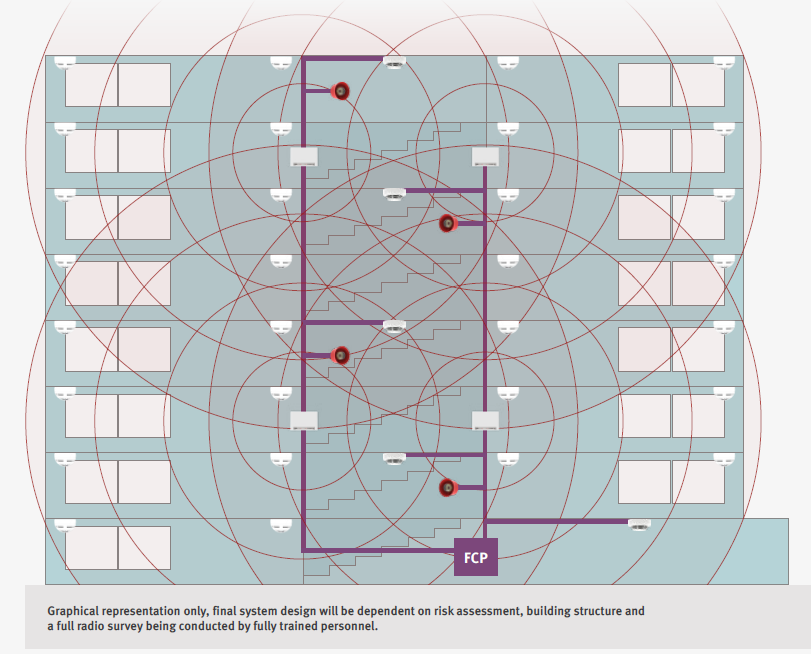Intelligent Fire Detection vs. Waking Watch
If you're looking for an alternative to Waking Watch for cladded buildings, contact Hochiki today for more information and to discuss your requirements.
Background
All across the UK the effects of the Grenfell Tower tragedy are still with us today, as multiple local authorities and private housing organisations continue to declare the presence of highly combustible cladding and/or insulation within their housing portfolios, rendering these assets non-compliant. The scope of work to replace all of the cladding so far identified is on-going and will take years to rectify based on conservative estimates.
Over the last year it has transpired that many residents of the affected buildings have been forced to remain in their properties, unable to secure insurance or mortgages, purely because of the cladding. Whilst this continues to leave many unsure of their safety in the long-term, in the short-term there have been several solutions proposed to mitigate the dangerous cladding issue, and one of them was the “Waking Watch” scheme.
What is Waking Watch?
Waking Watches were introduced by the National Fire Chiefs Council as a temporary measure to keep residents safe, involving trained fire wardens being present on site 24/7 to monitor the building’s interior and exterior, raise an alarm in the event of a fire and assist in the safe evacuation of residents during any incidence. But several years after the Grenfell Tower fire in 2017, hundreds of buildings across the UK still have 24-hour safety patrols in place, costing building owners tens of thousands of pounds every month. In most instances, the majority of these costs are being passed on to the leaseholders.
But updated guidance from the Council published in 2021 advised that building owners were to move to install common fire alarm systems as quickly as possible to reduce or remove the need for the 24-hour warden patrols.
Government Funding
On 17th December 2020, the UK government announced a £30m fund to help pay for the installation of fire alarms in high-rise buildings with dangerous cladding, the Waking Watch Relief Fund. On 16 September 2021 the Waking Watch Relief Fund re-opened to applications using additional £5 million funding. This application period closed on 10 December 2021.
A third round of applications was opened in January 2022 under the Waking Watch Replacement Fund, with an additional £27 million being made available by the Department of Levelling Up, Housing and Communities (DLUHC).
It means hundreds more buildings where leaseholders and residents have been forced by their freeholders to pay for costly fire safety patrols will now be able to install fire alarm systems instead at no cost to themselves, saving people on average £163 a month.
Building Safety Fund
The UK Government also set up the £1bn Building Safety Fund (BSF) in May 2020 to pay for the removal and replacement of unsafe, non-ACM combustible cladding systems on high-rise residential buildings in England that are 18 metres or higher. Applications to this fund closed on 30 June 2021.
Progress
With continuing media coverage and political pressure to make buildings such as Grenfell tower safer as a matter of urgency, a great deal of progress was seemingly made during 2021.
According to the most recent BSF update from the UK government, by the end of December 2021, 93% (449) of all identified high-rise residential and publicly owned buildings over 18 metres tall in England had either completed or started remediation work to remove and replace unsafe Aluminium Composite Material (ACM) cladding.
With regards to the Waking Watch Replacement Fund, £27.3 million of funding had been approved by December 2021, covering 323 buildings and an estimated 24,800 leasehold dwellings.
Local Authorities and Housing Associations
Advice issued to local authority chief executives and housing association chief executives by the Department for Communities and Local Government following the Grenfell disaster recommended a range of interim measures to protect residents within multi-storey housing with unsafe cladding issues. These were recommended by an independent panel of experts and included the provision of a temporary communal fire alarm system, to provide early detection of a fire condition:
“Provision of a temporary communal fire alarm system, comprising smoke detectors in circulation areas and plant rooms, and fire detectors (possibly heat detectors, rather than smoke detectors) in conjunction with fire alarm sounders in each flat. This will enable the entire block to be evacuated simultaneously in the event of fire… the system may comprise a wireless system, using radio to link devices".
– National Fire Chiefs Council

Hybrid Wireless Fire Detection
The recommendation for using a hybrid wireless fire detection system, installed as a temporary solution in this scenario has many benefits to both the building owner and residents:
- No cabling required, easy and quick to install, with minimum disruption to residents
- Operates on a robust, fast response intelligent radio link
- Offers 24/7 monitoring and reporting
- Can be maintained from one location within the building, via a fire control panel
- Doesn’t affect the fire compartmentation of the individual flats
- Easy to uninstall once cladding removed, with no damage to building structure
- One off investment plus small maintenance costs
- On site staff kept to a minimum
“An appropriate communal fire alarm and detection system will generally provide more certainty that a fire will be detected and warned at the earliest opportunity rather than rely on using trained staff”.
Guidance to support a temporary change to a simultaneous evacuation strategy in purpose-built block of flats, National Fire Chiefs Council
Intelligent Fire Detection vs Waking Watch
In the meantime, for all of those buildings that have yet to have their dangerous cladding removed, following the NFCC’s recommendations for installing fire detection system to replace a Waking Watch scheme will be the only viable short to medium-term solution.
According to a study by The Ministry of Housing, Communities & Local Government, the cost of employing one person/individual undertaking Waking Watch duties exceeds the average cost of installing an alarm system in 3 to 7 months, depending on the hourly rate charged. It should be noted that some buildings may require more than one Waking Watch individual to provide adequate interim fire safety measures.
Buildings Under 18 metres
On the lead up to the announcement that the Waking Watch Replacement Fund was being extended into 2022, Michael Gove, secretary of state for levelling up, housing and communities gave the UK construction industry an ultimatum – financially contribute to the remediation work required by all of the buildings less than 18m high that still have dangerous cladding and/or exterior insulation or face a potential trading ban.
Mr Gove highlighted the fact that the three manufacturers most closely associated with the problem cladding made over £700m in profits over the last four years.
The Construction Products Association has said in response that it is willing to continue working closely with the Government to find the right solutions for the cladding crisis.
Case Study
Residential Blocks, London
To further illustrate this, the Association of Residential Managing Agents provided a case study of one site in London consisting of 4 residential blocks and 191 dwelling units which received quotes for both installing an alarm system and employing a Waking Watch service. Quotes were received from three Waking Watch providers and were based on the provision of two people/individuals undertaking Waking Watch duties per block 24 hours a day, 7 days a week.
The costs of installing a fire alarm system across all 4 blocks was quoted to be £112,000 for a wireless system, this worked out as £586 per dwelling. The three Waking Watch quotes received all exceeded the cost of installing a wireless alarm system within 7 weeks.

Podcast
Listen to International Fire Protection's "Firecast", a podcast where the replacement of Waking Watch schemes by systems such as Hochiki's Hybrid Wireless Ekho is discussed and analysed against the backdrop of the Grenfell Tragedy.
Speakers include Hochiki's Tony Obadipe and FAFS spokesperson, Kevin Dodge.
Podcast duration: 26 minutes
Over 100 years in the Life Safety Industry
Hochiki’s expertise in fire detection is borne out of over 100 years of innovation in this field and our intelligent fire detection systems provide offer world proven reliability and flexibility. In our opinion, an intelligent, reliable, well maintained wireless fire detection system is the best temporary solution to protecting both lives and property in these scenarios.
How we can help...
If you are responsible for any high-rise building that has been identified as having a potential dangerous cladding issue, you will need to make an application for the Waking Watch Replacement Fund from the UK Government to help pay for the installation costs of a temporary fire detection system, such as Hochiki’s Ekho system.

Hochiki’s expertise in fire detection can help you make an informed choice on the options open to you. We will work directly with you alongside one of our preferred installation partners to quickly provide, design, install and maintain a temporary wireless Ekho fire detection system, specifically designed to protect your building and its occupants from a cladding fire whilst waiting for remedial work to commence.
Get in touch with our team today!
Contact us now using the form below and let us assist you in making your housing stock compliant and safe.
"We have been using Hochiki products for well over a decade now. Not only do we trust them to work, but we also trust the devices to last.
Dan Smith, KM Security Solutions




![Hochiki Global Banner Logo 2019 [white] [web] Hochiki Global Banner Logo 2019 [white] [web]](https://web.hochikieurope.com/hs-fs/hubfs/Hochiki%20Global%20Banner%20Logo%202019%20%5Bwhite%5D%20%5Bweb%5D.png?width=330&height=94&name=Hochiki%20Global%20Banner%20Logo%202019%20%5Bwhite%5D%20%5Bweb%5D.png)
